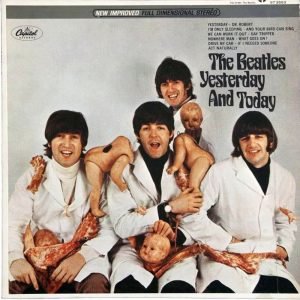In 1966, The Beatles found themselves at the center of one of the most notorious controversies in album cover history. The original artwork for their U.S.-only release, Yesterday and Today, featured the band dressed in white butcher smocks, draped with raw meat and dismembered baby dolls. Intended as a surreal, avant-garde statement rather than a deliberate provocation, the image quickly sparked outrage.
Retailers and radio stations condemned the cover as grotesque and inappropriate, leading Capitol Records to issue an urgent recall. The decision to replace the artwork turned the so-called “butcher cover” into one of the most infamous and sought-after collectibles in music history. The controversy not only highlighted tensions between the band and their U.S. label but also marked a shift in The Beatles’ evolving artistic expression.
Origins of the Photo
The infamous “butcher cover” was the brainchild of photographer Robert Whitaker, who envisioned the shoot as part of a larger conceptual art series titled A Somnambulant Adventure. Rather than a simple promotional photo, Whitaker aimed to create a surreal, thought-provoking image that challenged the conventional perception of The Beatles as clean-cut pop stars.
The session featured the band in bizarre, dreamlike setups, with the butcher-themed shot standing out as the most striking. John, Paul, George, and Ringo wore white smocks while surrounded by raw meat and dismembered baby dolls—imagery meant to symbolize the dehumanizing effects of fame and the way the music industry “butchered” artists for commercial gain. The Beatles, known for their playful and irreverent sense of humor, went along with the concept, likely underestimating the backlash it would provoke.
The Album Release and Immediate Backlash
Capitol Records, always looking for ways to package and repurpose The Beatles’ music for the American market, selected the butcher cover for Yesterday and Today, a U.S.-only compilation album. Whether the label fully understood the artistic intent behind the image is unclear, but they approved its use—possibly seeing it as an eye-catching, unconventional choice.
The reaction upon release was swift and overwhelmingly negative. Retailers were horrified, with some refusing to stock the album, calling the cover tasteless and disturbing. Radio stations received complaints from shocked parents, and industry executives worried about the impact on The Beatles’ family-friendly image. Under mounting pressure, Capitol recalled the album just days after its release, halting distribution and scrambling to replace the offending artwork.
The Recall and Replacement Cover
Faced with overwhelming backlash, Capitol Records made the costly decision to recall Yesterday and Today and replace its controversial artwork. The recall affected approximately 750,000 copies that had already been printed, making it one of the most expensive mistakes in the label’s history.
Rather than destroying the existing inventory, Capitol opted for a cost-saving measure: pasting a new cover image over the original butcher cover. The replacement photo, hastily arranged, featured The Beatles posed around a steamer trunk in a far more conventional and inoffensive setup. This “paste-over” strategy was meant to be a quick fix, but over time, collectors discovered that the original image could sometimes be revealed by carefully peeling away the top layer. This discovery turned surviving butcher covers into some of the most valuable and sought-after collectibles in Beatles history.
Collectibility
The butcher cover recall turned what was initially a public relations disaster into one of the most legendary collectibles in music history. Original, unaltered copies are exceedingly rare, while paste-over versions—where the replacement cover was glued on top—became a fascination for collectors. Over time, techniques were developed to carefully remove the top layer, revealing the infamous image beneath.
Today, surviving butcher covers are among the most valuable pieces of Beatles memorabilia, with pristine first-state (uncensored) copies selling for tens of thousands of dollars at auctions. The controversy also cemented the cover’s place in rock history, serving as a reminder of The Beatles’ evolving artistic ambitions and their growing defiance of industry constraints. While it may have been unintended, the butcher cover became an enduring symbol of the band’s rebellious spirit.
